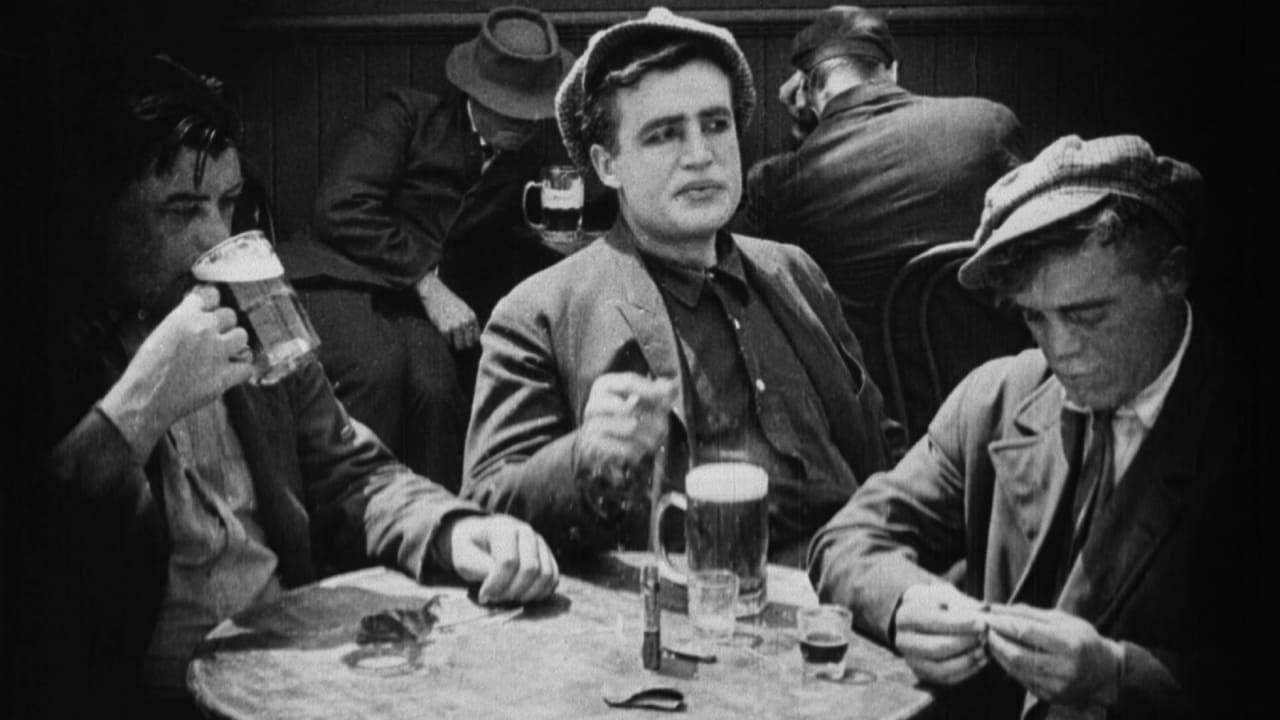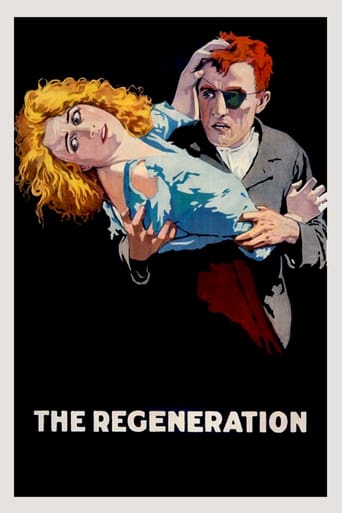

Directed by Raoul Walsh, this is an exciting and poetic film, using all the elements at play in his greatest movies. Those signatures really stand out, even all the way back at the beginning of his career.It's the story of a tenement street kid who loses his kindly mother at age 10. (The scene that starts the film is quite moving. This is not to be a comic adventure film, but a very serious drama). The boy is taken in by a neighbor woman, a harridan, but a kind hearted one whose husband is a drunkard who beats her and the boy every chance he gets. The boy starts to lose whatever humanity he had, due to the influence of this battling couple.He rises to a position of 'prominence' in the tenement community over the years, since he has all the things that the denizens of the street find attractive - a devil may care attitude, a sense of daring, a lot of strength and good looks. He's never lost his inner gentle nature, but it's hidden under a mask of bravado and cynicism that he needs to survive. The actor, Rockcliffe Fellowes, looks like a cross between Marlon Brando, Jimmy Cagney and Jason Segal. He's quite good... in fact he totally reminds me of Brando in THE WILD ONE. The camera loves him. As Owen, he's able to play both sensitive and tough, which is a magic combination for Walsh.He falls for Marie whom he calls Mamie Rose (Anna Q.Nilsson), a wealthy girl who is being groomed by her parents for marriage to the city's new District Attorney. The DA has just been appointed and tells all the newspapers that he is cracking down on crime. One night, the girl tells the DA that she wants to see what the street toughs are like for herself. The DA tells her and her friends that he knows a dive where they can see all the lowlifes they want to. Of course, after having his picture in the papers all over town, the DA is immediately recognized and the crowd starts to heckle him showing him how tough they really are. The girl cries out for someone to help the foolish DA, and our Owen breaks up the crowd and leads them to safety. Owen is smitten, and Mamie is struck hard with the need to help the poor and destitute.She immediately starts work in the neighborhood, doing good deeds and handing out medicine and money to the needy. The rest is just about what you would think a Walsh film would be, with Owen trying to make good out of unrequited love for Marie, who doesn't really realize his feelings. He finds inspiration to become better educated and make something of himself through her ministrations. She turns to him as a pillar of strength when things go wrong.His loyal pal, a street kid who has a deformity who Owen once saved from being made fun of, is a splendid actor. All of the street toughs really look like street toughs, which is refreshing and a bit scary. Walsh builds up the action in a very similar way to The Roaring Twenties, with a really evil gang leader who takes over when Owen tries to goes straight. There was a surprise ending, for me anyway.This film was very well done for the time it was made and I can see how it made Walsh famous. It made me love him all the more for his sensitivity and realism.
... View MoreWhat a super movie - it had thrills, suspense and a very surprising finish, you have to keep reminding yourself it is over 96 years old!!! Anna Q. Nilsson may well have been one of the first film stars to freelance. She was a beautiful Swedish actress who had been working at Kalem for four years. Unfortunately her salary had not increased (much) and she had just divorced her husband who happened to be Kalem's leading actor.Raoul Walsh esteemed her talents as an actress enough for him to cast her in "Regeneration", his first major directorial assignment and a sensational crime movie based on Owen Kildare's popular play, "My Mamie Rose", which was said to be autobiographical. Walsh, a disciple of D.W. Griffiths, may even have surpassed his master in some of the scenes from this movie. The crowd scenes at Grogans captured the color and vibrancy of the city's melting pot of people. Outside of a few scenes in a Bowery mission it was all filmed on the streets of New York, including scenes on the Hudson River.The film begins with young Owen, due to the death of his mother, being taken in by his neighbours, the Conways, a rough couple who soon familiarize Owen with tough, unforgiving tenement life. Owen (Rockcliffe Fellows) is eventually hardened to the "might is right" way of the streets and by his mid twenties is the leader of a tough street gang. The new D.A. vows to stamp out the gangsters but bows to pressure from butterfly socialite Marie (Nilsson) who longs to see a gangster close up. He takes her to Grogans, the local gangster haunt but is involved in a scuffle and Marie's real distress catches Owen's attention. He breaks up the fight but the incident awakens Marie's better self and she soon finds herself running a settlement house in the heart of the gangster district. The day everyone looks forward to is the annual treat, a day of pleasure on a large boat. The fire on board the boat showed Walsh's superb handling of crowds - people madly running everywhere, the plunging into the river, the frantic scramble to get to a boat that eventually collapses through overloading and the end title that declares "All the kiddies were saved"!!! Apparently Walsh hired thugs from Hell's Kitchen to round up some extras from the Bowery and when there weren't enough women he offered some men extra money to dress up as women and it made for a vivid and realistic sequence when they all jumped into the water. William Fox was so impressed that he raised Walsh's salary to $800 a week!!There is even a graphic (for 1915) scene of drug use. A woman flees to the settlement begging that someone rescue her baby from the dwelling she shares with her drug addicted husband. Owen, who is not involved with the settlement, is deemed the man for the job and when he goes to the room and finds the man in a groggy state, by rescuing the baby his salvation begins. Children are symbols of innocence and purity - Owen, as a child, was seen as a loving little boy who was corrupted by the adult couple who took him in and in the fire sequence, Owen runs back to the boat to save two little girls. Griffith's influence is seen in the pathos, when Marie realises Owen has secretly helped a friend, "Skinny", to avoid a serious charge although in Owen's favour, he wants nothing more to do with "Skinny" - it was as a favour to repay a childhood debt.Interspersed between a brutal near rape scene are various Griffith inspired titles, very flowery, some with biblical quotations.
... View MoreBy the standards of its time, this is a better than average film, and it is still watchable, even though the social and cinematic conventions of 1915 may make it rather quaint to some viewers. Still, the theme about a good woman regenerating a rascal is not unusual today, and here it is told with coherence and simplicity.One may find the acting style quaint, too, but some of the worst excesses of the silent days are avoided for the most part. Perhaps we can thank young Raoul for that. The editing is choppy, but that may be due to losses over the years, and it may vary depending on the print or tape translation one sees.
... View MoreRaoul Walsh had just come off _The Birth of a Nation_ both as one of Griffith's assistant directors and as an actor (most prominently as John Wilkes Booth), when he made this film. In his autobiography, Walsh credits Griffith with "teaching" him not only about much of the art of fiction filmmaking, but also about production management technics that aided him in taking full advantage of many of New York City's most pictorial exterior locations.The locations play an important role in adding to the naturalism of an otherwise highly melodramatic plot with the high society young woman turned heroine social worker (much overplayed by a major star of the 1910s, Anna Q Nilsson) and the regeneration of the one-time Lower Manhatan gang leader.The wonder of this film is the performance of the male "star", Rockliffe Fellowes, who played in over a dozen nearly unremembered films until he died in 1950. His performance is so subtly varied and electrically alive that one is reminded of Brando in his early 1950s films. An interesting sidenote about his performance: The movieola film editing machine -- that magnified the small 35mm frame to about 4 inches by 6 inches as it ran the film stock through the viewer at the proper projection speed -- was not invented until much later. In 1915, editors had to hold the footage up to the light to see each frame and/or use a magnifying glass; but they could not also run the film at speed at the same time. Hence, many of the subtlest nuances that cross the hero's face could not be clearly seen and judged in editing: _Regeneration's_ editor often cuts away before the movement has settled, or cuts into a close or medium shot of the hero after the nuance has already begun.Watching the film on a large screen today, one is aware how powerful present-day editing technics are at capturing all such movements in the hands of a skilled editor. In _Regeneration_ there is a distinct feeling of rough editing at the moments we leave or cut to the hero at the "wrong" instant. By the way, the original title was NOT _The Regeneration_, but _Regeneration_ alone. From which we can surmise that Walsh was looking to create a work with universal meaning.
... View More